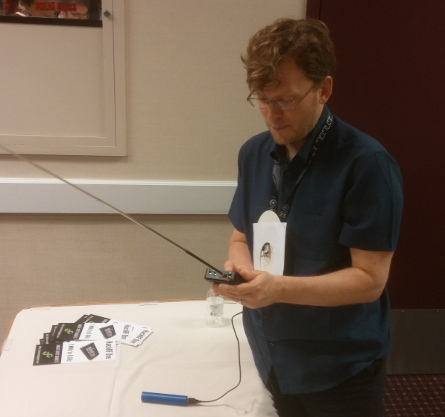PortaPack H1 at DEF CON 23
Jared Boone of ShareBrained Technology gave demonstrations of his new PortaPack H1 at the DEF CON 23 Demo Lab. I joined him at his table to help talk with people about the add-on for HackRF One.

PortaPack H1 turns HackRF One into a portable SDR platform. With an LCD, navigation control, and audio input and output, the device can be used as a handheld spectrum analyzer and can implement a wide variety of useful radio functions. A microSD slot on the PortaPack can be used for waveform or firmware storage, and a coin cell keeps the real-time clock and a small amount of configuration RAM going while the device is turned off.
Of course, the hardware designs and firmware for PortaPack H1 are published under an open source license. Jared has done an amazing job of implementing SDR functions for PortaPack that run entirely on HackRF One's ARM Cortex-M4 microcontroller.
To use PortaPack H1, you'll need a HackRF One, and you'll probably want a USB battery pack to make it a fully portable solution. Another popular add-on is the beautiful milled Aluminum enclosure for PortaPack. Jared provides a ShareBrained Technology guitar pick with every PortaPack H1. It is the perfect tool for opening your HackRF One's injection molded plastic enclosure prior to PortaPack installation.
There was a wonderful moment at the Demo Lab when Jared tuned his PortaPack to a frequency being used by Ang Cui at a nearby table. Jared's PortaPack was plugged in to a small speaker, so we could all listen to the AM radio transmission originating from a printer at Ang's table. The printer was physically unmodified but was running malicious software that transmitted radio signals with a funtenna! For more information about Ang's implementation, visit funtenna.org.
My First Look at rad1o Badge
Over the next several days, thousands of hackers will gather at the Chaos Communication Camp in Germany. An electronic badge for the event is being prepared, and it is based on my design for HackRF One!
At DEF CON over the weekend, I was fortunate to be able to meet up with Ray, one of the members of the Munich CCC group responsible for the rad1o badge. Ray was wearing one of the prototype units, so I was able to take a close look.

The design is a variation of HackRF One. It includes a small LCD and an audio interface, so it is a bit like having a HackRF One plus a PortaPack H1 on a single board. A slim, rechargeable LiPo battery is mounted on the back. The visual design of the PCB looks like a traditional AM/FM radio receiver complete with an antenna (which is not the actual RF antenna) and a dial (which is not really a dial).
There are some design modifications, especially in the RF section, that seemed strange to me at first. The reason for many of these changes is that the rad1o team was able to get certain chip vendors to agree to sponsor the badge by donating parts. By redesigning around donated components they were able to reduce the cost to a small fraction of the cost of manufacturing HackRF One, making it possible to build the rad1o badge for several thousand campers.
The firmware for rad1o is derived from HackRF One firmware but is in a separate repository. Because of the LCD and other differences between the two hardware designs, they are not firmware-compatible. When using rad1o as a USB peripheral, it is fully supported by existing software that supports HackRF One. Future rad1o firmware will use a USB product ID of 0xCC15 assigned from the Openmoko pool, but the shipping firmware will borrow HackRF One's product ID. This will ensure that any existing software for HackRF One will work with rad1o during camp. The new product ID (0xCC15) is already supported in libhackrf release 2015.07.2, so it should be easy for people to update to it in the near future.
If you are new to Software Defined Radio and are looking forward to using the badge as a way to get started with SDR, I recommend starting with my video series. You might want to download the videos before leaving for camp. Also take a look at Getting Started with HackRF and GNU Radio and the recommended software for rad1o. If you plan to do firmware or hardware hacking, be sure to clone the rad1o repositories. For examples of Digital Signal Processing (DSP) on the LPC43xx, I suggest studying Jared Boone's firmware for PortaPack H1. Also check out the video of Jared's Software-Defined Radio Signal Processing with a $5 Microcontroller at BSidesLV 2015.
As an open source hardware developer, it is extremely satisfying to see folks start with my design and do something amazing like the rad1o badge. I'm excited to be attending camp for my first time ever, and I can't wait to see the projects people will come up with!

